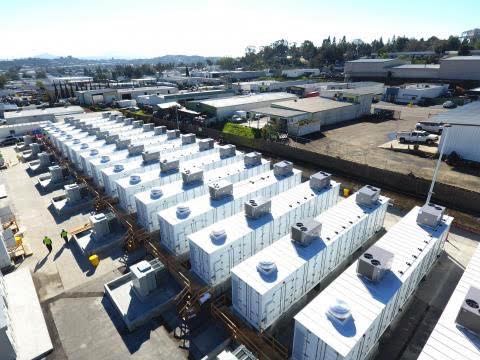The energy storage divisions of two of the world’s biggest energy companies – AES and Siemens – have joined forces to tackle the likes of Tesla and seek to dominate the soaring global battery storage market.
And Australia, where Tesla has just announced what will be the biggest lithium-ion battery storage market in the world, is high on the list, and AES expects to announce a series of major, and bigger, battery storage projects in the coming months.
The creation of the jointly owned Fluence was announced overnight in Washington, DC. It will focus exclusively on grid-level storage, rather than in the household market, with a minimum size of 100kW.
AES already claims to be the market leader, but says that by combining with the Siemens battery storage division, it will be firmly established as the biggest in the market, and well placed to deal with new competitors like Tesla.
AES sees the market for grid scale battery storage jumping from just 3GW in 2016 to 28GW in 2022, and John Zahurancik, the president of AES Energy Storage, says Australia has jumped into one of the top five global markets, thanks to elongated network, and the rising share of renewable energy.
“Australia has moved itself into one of top 5 markets in the world,” Zahurancik told RenewEconomy in an interview. “You are sitting in the middle of one of the hot markets.
“There are lots of fundamentals that would encourage more storage in Australia – the lack of new dispatchable electricity, the growing renewable share, remote grids, its geographical limitations and the significant points of congestion. They all are points that make storage very valuable.”
AES is currently partnered with Lyon Group, which has ambitious plans to build more than 1GW of solar and more than 600MWh of battery storage in South Australia, Victoria and Queensland.
Even though three of the bigger projects have received a lot of publicity, the final go-ahead has not been given, and the company has indicated it will “tender” for the services that its battery storage will provide.
Zahurancik says AES is involved with a “number of other companies’ that are looking at battery storage installations in Australia, in the range of 20MW, 30MW, 50MW and bigger.
“We expect that some of these projects will come on towards end of this year and others will follow on after that. The question is do all the things that are talked about move forward. Will there be sustainable set of conditions going forward – or is this just a response to a crisis?”
It is true that the Tesla storage installation, commissioned by the South Australia government, comes under the general rubric of crisis management. The Australian Energy Market Operator says it will be essential to help keep the lights on this summer.
Most of its capacity will be focused on grid support, with only 30MW (but with three hours storage) assigned to shift the load of the wind farm.
Lyon Group, however, is looking at bigger investments in battery storage combined with large scale solar plants, with their 100MW facility in South Australia designed to have four hours storage, so a total of 400MWh. Similar-styled projects are planned in Victoria and Queensland.
AES has also been contracted to build a 100MW/400MWh battery storage installation in California under a 20 year agreement with Southern California Edison. It is designed to replace ageing and increasingly expensive gas generators in that state, and Zehurancik sees similar opportunities in Australia.
“Battery storage can do a relly good job – they can be utilised to a much degree than a gas speaker, and it is becoming the preferred choice for some locations,” he says.
“Storage would be used daily – they can do grid balancing, instant response for correcting faults, and it can be used daily for helping meet demand peaks.
Zahurancik says the high cost of network and generation in Australia makes it an interesting market, particularly as the cot battery storage falls.
He estimates the cost has fallen 90 per cent since AES first entered the market a decade ago, and will fall another 50 per cent over the next few years as efficiencies and energy density are improved.
“Battery storage is becoming a solution because of its flexibility, the ease of permitting, and its scaleability, and because it can be deployed very rapidly,” he said.
Siemens recently formed a partnership with Eos Energy Storage to integrate, install and service energy storage solutions, and has hitherto focused on the smaller commercial and industrial sectors.
Ralf Christian, CEO of Siemens’ Energy Management division, said that as the energy storage market scales, customers face the challenge of finding a trusted technology partner amidst “conflicting technical claims, inexperienced vendors and installers and new market entrants with limited power sector knowledge.”











